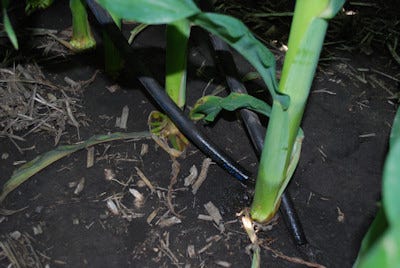
What do you do after years of consistently increasing yield on your farm? Brian Corkill, BA Farms, Galva, says you keep pushing it. Corkill and his father have more than 20 years of yield data and a decade of precision data to help make management decisions. “Maybe some of the basic stuff guys are starting to work with now, we’ve already figured out and know what works and what doesn’t in our operation,” Corkill says. “Now we can take it to the next step.”
The next step: sidedressing NPK and KTS.

FLEXIBILITY: “The ability to go out with a rescue (nitrogen application) at a later stage is pretty valuable,” says Brian Corkill, who farms near Galva. “That’s the beauty of being able to do it (apply nitrogen) this time of the year. If it’s a wet year like last year, we could add more if we needed it.”
“We want to see if there’s a benefit to split feeding more nutrients,” Corkill says after applying 2.5 gallons per acre of KTS on V16 to V18 corn that received 32% five days prior. He also ran a trial of 8-19-3 and 32% nitrogen at V6. Corkill notes he planned to use 10-34-0, but it wasn’t available. This fall, their precision Ag consultant will analyze the data and determine if the additional sidedressed nutrients impacted yield. Corkill says owning a Hagie sprayer and Y-drops gives them flexibility to tweak nutrient management plans and find new ways to increase yield.
The Corkills invested in their own sprayer last year to modify their approach to nitrogen management. “It’s our opinion, at some point in time, we’ll be forced into doing things different than in the past,” Corkill says. “We wanted to be ahead of the curve and figure out some things that work so we can prove to whoever is going to tell us what we can and can’t do this works. We can manage nitrogen efficiently and it doesn’t end up being a disaster.”

NUTRIENT BOOST: “We want to see if there’s a benefit to split feeding more nutrients,” Corkill says after applying NPK and KTS with his Hagie sprayer and Y-drops in late June.
Five years ago, Corkill transitioned away from applying all his nitrogen in the fall to splitting it two-thirds in the fall and one-third pre-plant. Last year, he went a step further by enrolling half his acres in Encirca Nitrogen Management, using soil samples to plan applications on the remaining acres and “spoon feeding nitrogen” later in the season.
Corkill says last year’s modified nitrogen plan paid off.
After Corkill applied all his planned nitrogen, Encirca showed the crop needed more after the heavy rainfall in June and he sidedressed all of his acres over the 4th of July. The “rescue application” acres yielded 10-12 bushels more than the check strips.
“The ability to go out with a rescue at a later stage is pretty valuable,” Corkill says. “That’s the beauty of being able to do it this time of the year. If it’s a wet year like last year, we could add more if we needed it.”
Or, do the “right thing for everybody” and the environment and cut applications, Corkill says.
“If meteorologists were right and we had a drought like many were calling for this year, or a year like 2012, we may forgo more nitrogen at sidedress if the crop didn’t need it,” Corkill says. “In the past, we were locked in after putting it all on prior to planting.” He notes Encirca shows minimal nitrogen loss this year due to dry conditions. Corkill applied 100 units in the fall and 45 to 60 units preplant, depending on soybean or corn-on-corn acres. He added a variable rate sidedress application, ranging from 35-40 units per acre.
Turning to cover crops
Nitrogen application timing wasn’t the only change to crop plans five years ago; Corkill says they plant cover crops on the majority of their acres for “nutrient recycling”. He notes the hardest part of their new approach was establishing cover crops.
“The first two to three years, we tried using annual ryegrass and it winterkilled and we ended up with nothing,” Corkill explains. He believes planting cover crops with an air seeder on a vertical tillage tool is the more effective than flying them on. Last fall, their cover crop mix was split 50/50: cereal rye, barley, tillage radish, canola (rapeseed) and oats on half the acres and the rest is straight cereal rye.
Corkill says weed control and water availability are two unexpected bonuses from cover crops.
“The cover crops do a nice job suppressing waterhemp, which is our biggest issue right now,” he says. In early June, when timely rains were few and far between this spring, testing revealed his cover crop fields had three-fourths of an inch more water available compared to no-till corn stalk fields.
With nitrogen management, cover crops and the addition of in-season nutrients, Corkill hopes to “accelerate” yield increases on BA Farms. Last year, their corn averaged 220 bushels per acre and so far, Corkill says crops look better than last year at this point in the season.
“I’m cautiously optimistic it will be even better this year,” he says.
Get our FREE report Cover Crops: Best Management Practices
About the Author(s)
You May Also Like




